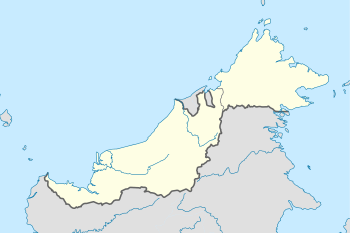Song, Sarawak
| Song | |
|---|---|
| Town | |
| Chinese transcription(s) | |
| • Simplified | 桑 |
 Song Location in Borneo | |
| Coordinates: 2°01′N 112°33′E / 2.017°N 112.550°ECoordinates: 2°01′N 112°33′E / 2.017°N 112.550°E | |
| Country |
|
| State |
|
| Division | Kapit Division |
| District | Song District |
| Population [1] | |
| • Estimate (2010) | 20,046 |
| Time zone | MST (UTC+8) |
| • Summer (DST) | Not observed (UTC+8) |
| Postal code | 96850 |
Song is a town, and the capital of the Song District (3,935.2 square kilometers)[2] in Kapit Division, Sarawak, Malaysia. The district population (year 2010 census) was 20,046.[1] Song is situated by the banks of the Katibas River, a tributary of the Rajang River. The Iban(Sea dayak) people form the majority in Song, followed by the Orang Ulu, Chinese, Malay, Melanau and Bidayuh. It is an important stopover for river traffic going up the Rajang River.
Song at a glance before 1963
_in_1960s.jpg)
The town located on the Song River was originally a Malay trading port. "Abang" (patrician of Sarawak Malay) is a well-known figure Hj. Ahmed b. Hj. Omar and Melanau where they exchanged their forest products such as Nyatoh, resin and rattan in 1820s with local Iban people in Song. The Iban indigenous people inhabited the area along the Rejang River, Katibas River, Song River, Lajan River, and Iran River.
The traders brought products to Sibau (Sibu) to sell, where there were ships, such as the Ang Bee from Singapore and the Kampar from Peninsular Malaysia. These ships stopped at Sibau before bringing goods to Singapore and Peninsular Malaysia at that time. Similarly, the trader brought essential households items like salt, apong Sugar, salted fish, platter bowls, pottery, clothing, gongs, fabric and clothing to be used as exchange with the local traders.
History
The history of Song goes back to the early part of the 19th century. In those early days, Song was a settlement where Malay traders came upriver to trade forest products such as rattan with the Melanaus. The forest products were then taken downriver to the port in Sibu for export. In return, the tribes purchased daily goods such as salt, sugar, and salted fish, as well as crockery, china, gongs and textile.
The Industrial Revolution in Europe created a demand for raw material, and this propelled the growth of Song from a settlement into a small village. Chinese migrants from Fujian province settled here, building a row of shophouses in the village. Malays also came to settle in Song, establishing a Malay kampung called Kampung Gelam. As a result of the increased importance of Song, the White Rajah set up an administrative centre for Song. It was located at the estuary of the Song River in 1870. Around that time, and until the turn of the 20th century, there were repeated uprisings staged by the Iban tribe against the imposition of taxes.
Song was under Japanese occupation from Christmas Eve of 1941 until September 1945. Allied bombings destroyed much of the buildings in the village including the district office. This compelled the district officer Abang Tunku Haji Wan Mat to relocate the administration of Song to the estuary of the Katibas River. The Song Fort was built there in 1947 and the Song Administrative Office was relocated to it the following year.
Transportation
Song is only accessible by express boats along Rejang River. There are hourly express boat services connecting Song, Sibu, Kanowit, Kapit and Belaga.It is approximately 2 hours journey from Sibu and an hour from Kapit.The express boats services are provided frequently at Song Wharf Terminal.
However,a plan to build roads connecting Song to Kapit and Song to Kanowit was promised by the Federal Government and was announced by the Prime Minister of Malaysia during his visit to the town on 15 April 2011.
Schools
Secondary Schools:
- SMK Song
- SMK Katibas
Primary Schools :
- SK (C) Hin Hua
- SRB Cardinal Vaughan Song
- SK Nanga Beguang
- SK NangaTemalat
- SK Nanga Bangkit
- SK Ulu Melipis
- SK Nanga Selibut
- SK Tan Sri Datuk Temenggong Jugah
- SK Nanga Nansang
- SK Nanga Musah
- SK Nanga Janan
- SK Nanga Engkuah
- SK Nanga Embuau
- SK Nanga Dalai
- SK Nanga Nyimoh
- SK Lubok Ipoh
- SK Lubok Bedil
References
- 1 2 "Laporan Kiraan Permulaan 2010". Jabatan Perangkaan Malaysia. p. 35. Retrieved 2011-01-24.
- ↑ "Latar Geografi Daerah Song". Pejabat Daerah Song. Retrieved 2011-01-24.